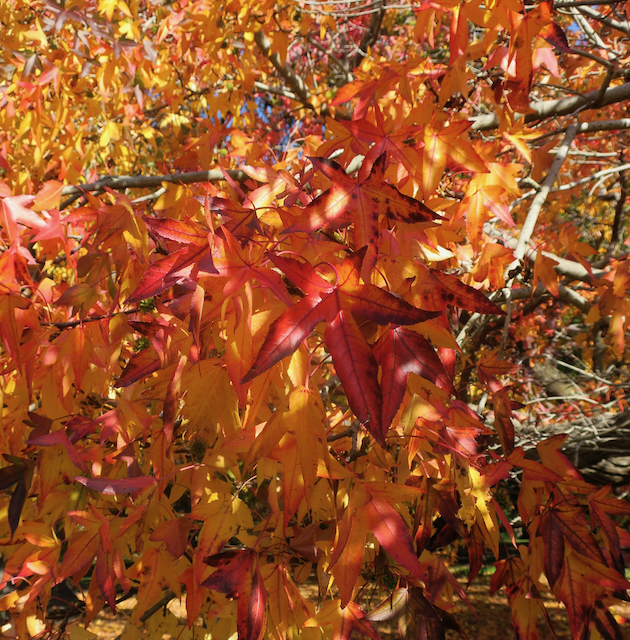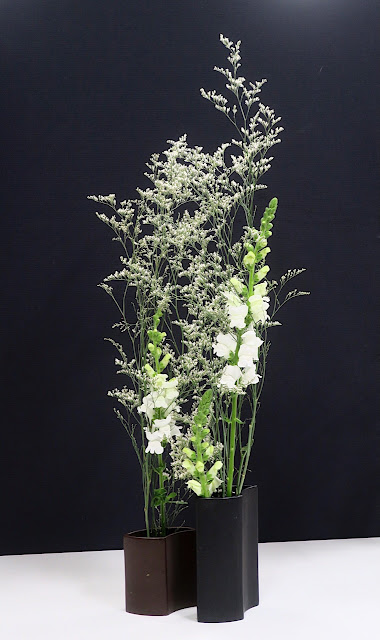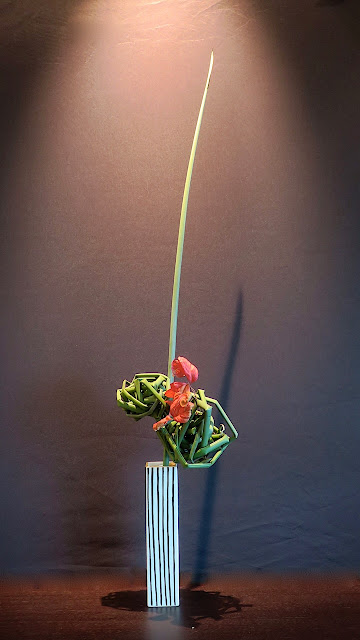Marisha had two lengths of Wisteria vine that were too long to be supported from a single cylindrical vase, so a second one was brought into play. This meant that the vine could be extended and intertwined without the risk of it breaking. Two Asiatic Lilies were placed toward the back to maintain the focus on the vine.
AUTUMN TRANSITIONING INTO WINTER
Marisha had two lengths of Wisteria vine that were too long to be supported from a single cylindrical vase, so a second one was brought into play. This meant that the vine could be extended and intertwined without the risk of it breaking. Two Asiatic Lilies were placed toward the back to maintain the focus on the vine.
ITS NOT EASY BEING GREEN *
Maureen used green gumnuts and Leucadendron branches. She also used some dyed Mitsumata Edgeworthia, one of the plants commonly used in making Japanese paper. This plant is unusual in that it naturally forms three branches at nodal points. The unusual branches are processed and bleached or coloured for use in ikebana.
My own ikebana this week uses Hydrangeas from the garden at the end of their Autumn phase. In early summer they are white; they slowly become pink; before going green then red in Autumn. The single leaf is from our slow-growing Gymea Doryanthes palmeri, a gift from my colleague Emily Karanikolopoulos. Some mechanics were necessary to achieve the floating of the leaf across the vase opening. It is secured to a vertical stem that is anchored in a kenzan at the bottom of the vase.
The vase is by the Victorian ceramic artist Arnaud Barraud.
19th May 2024
AUTUMN COLOURING
Marta's principal material was Smokebush Cotinus, Japanese maple Acer palmatum and fine lines from an unidentified branch that had been stripped of its leaves.
Pamela also used Manchurian pear, Japanese maple and some Cotoneaster providing a green contrast and the addition of red berries.
DEMONSTRATION
The next curriculum exercise was to make a "Composition of Curved lines". I have used Coast Sword Sedge Lepidosperma gladiatum, which has beautiful glossy green leaves that curve particularly well. The contrasting mass is made with two Hydrangea flowers from our garden, which have coloured to a rich red in the cool night air. The unglazed vase is by Don Jones, a South Australian ceramic artist.
This ikebana has the theme of using "Seasonal Plant Materials". In this case the autumnal materials left to right are: Nandina domestica leaves, Hydrangea leaves and a flower, orange Pittosporum P undulatum berries and Medlar Mespilus germanica. The box-shaped ikebana vessel is by the Canadian ceramic artist Leta Cromier
The theme of my final ikebama was "A composition of Mass and Line". In this case I created two knotted-looking masses using the stems of Strelitzia Juncea. I began by bundling four stems together and then randomly bending them across each other. The mass on the right is rather loose, while that on the left is tighter. The masses have been attached to the vertical line of the same material that arises from the centre of a tall narrow Japanese vase. A small mass of Nandina domestica Nana, leaves have been added to provide a colour focus.




































